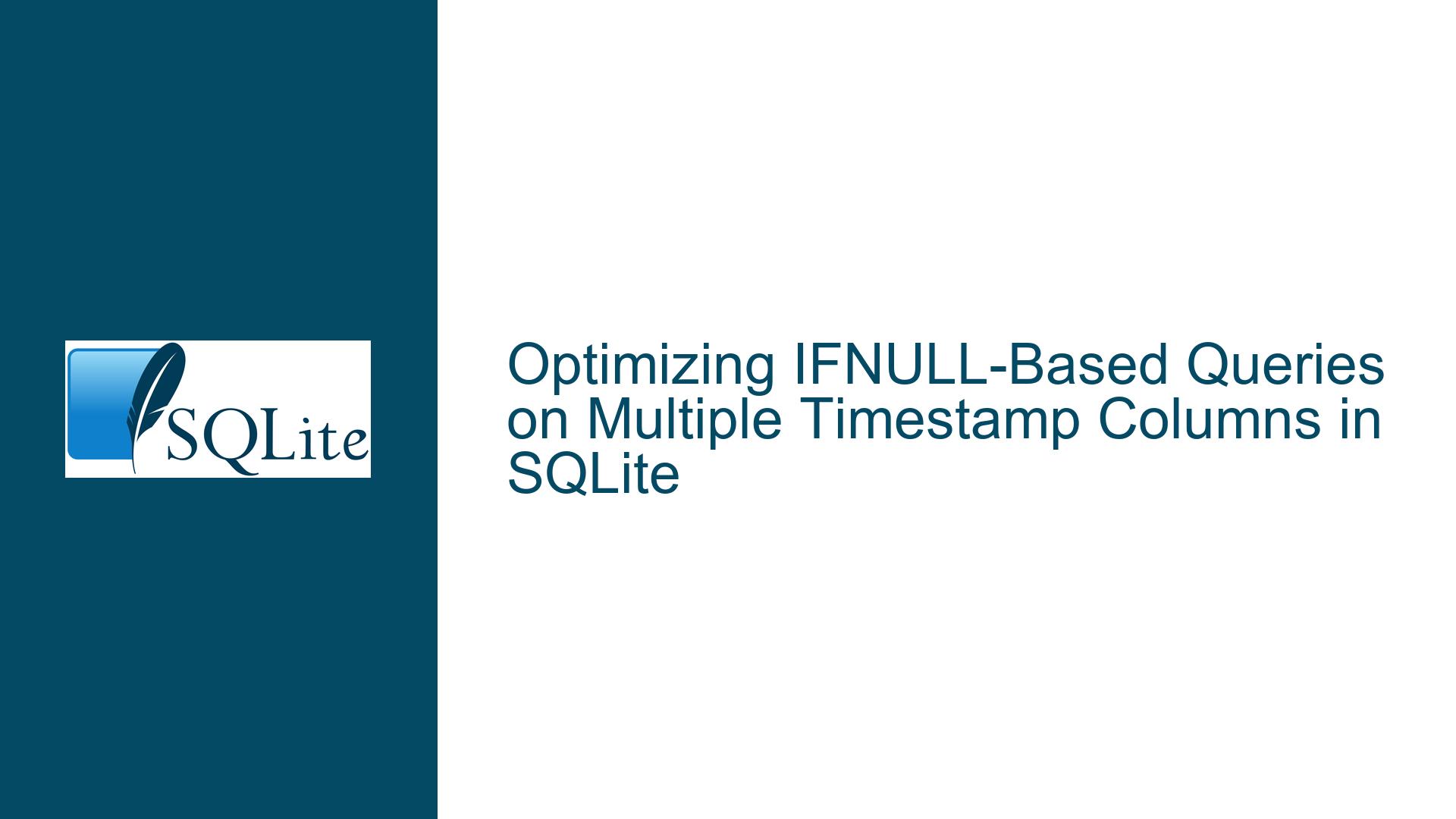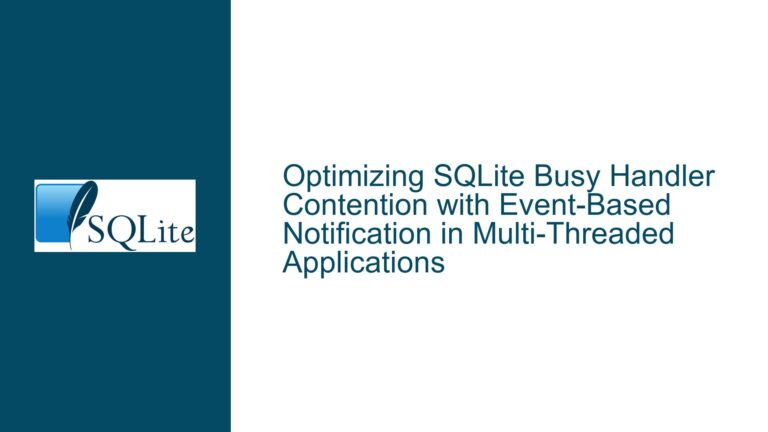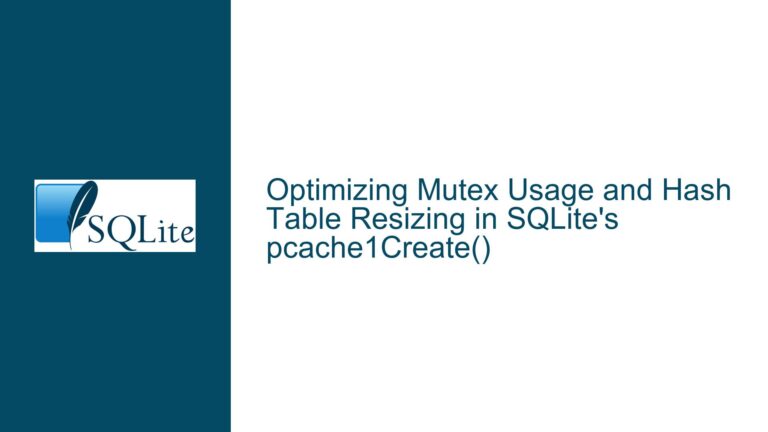Optimizing IFNULL-Based Queries on Multiple Timestamp Columns in SQLite
Understanding Table Scan Behavior When Filtering with IFNULL(updatedAt, createdAt)
The core challenge revolves around efficiently querying a table containing creation and modification timestamps while avoiding full table scans. Consider a table structured as follows:
CREATE TABLE example_entries (
id INTEGER PRIMARY KEY AUTOINCREMENT,
name TEXT,
updatedAt INTEGER,
createdAt INTEGER NOT NULL
);
In this schema, createdAt is populated during record insertion while updatedAt remains NULL until subsequent modifications. A common requirement involves retrieving records modified after a specific timestamp, falling back to creation timestamps for unmodified records. The initial approach uses:
SELECT id, name, IFNULL(updatedAt, createdAt) AS effective_date
FROM example_entries
WHERE IFNULL(updatedAt, createdAt) >= @target_ts;
Despite separate indexes on updatedAt and createdAt, this query triggers a full table scan because:
- Function-Based Filtering Limitations: SQLite’s query planner cannot decompose the
IFNULL(updatedAt, createdAt)expression into discrete index lookups - NULL Handling Complexity: The
updatedAt IS NULLcondition creates branching logic that standard b-tree indexes cannot natively resolve - Expression Evaluation Order: The combined timestamp comparison operates after row retrieval, forcing evaluation against raw table data
This manifests as O(n) read operations proportional to table size – a critical concern in systems like Turso where read operations carry financial and performance costs. Execution plans reveal SEARCH TABLE example_entries USING INDEX is absent, replaced by SCAN TABLE example_entries.
Why SQLite Fails to Leverage Basic Indexes for IFNULL Expressions
1. Expression Collapsing in Query Planning
SQLite’s optimizer cannot automatically transform IFNULL(col1, col2) into equivalent col1 OR col2 logic during index selection. The function wrapper obscures the underlying column relationships from the index matching algorithms. This differs from simple column references where the planner directly maps WHERE clause elements to index segments.
2. Index Key Composition Constraints
Traditional single-column indexes store sorted keys for one column. When querying IFNULL(updatedAt, createdAt), the effective sort order combines two columns with NULL semantics. No existing single-column index captures this combined sort order, forcing sequential scanning.
3. NULL Value Exclusion in Index Storage
Standard indexes omit entries where the indexed column is NULL. Since updatedAt starts as NULL, its index lacks these initial records. The query’s fallback to createdAt requires accessing data not fully represented in either individual index.
4. Compound Index Key Mismatch
A compound index on (updatedAt, createdAt) would order first by updatedAt, then createdAt. This doesn’t align with the IFNULL logic requiring either:
updatedAtif non-NULL, elsecreatedAt
The compound index would still require scanning all updatedAt NULL entries and comparing their createdAt values separately.
5. Function-Based Index Awareness Gap
Without an explicitly defined index on the IFNULL expression, the optimizer lacks metadata about the expression’s sort order or coverage. It cannot verify if an existing index sufficiently covers the expression’s output.
Implementing and Validating Index-Driven Solutions for IFNULL Timestamp Logic
Solution 1: Expression Index on IFNULL(updatedAt, createdAt)
Step 1: Create Targeted Expression Index
CREATE INDEX idx_effective_date
ON example_entries(IFNULL(updatedAt, createdAt));
This index explicitly stores the computed IFNULL results in sorted order, enabling direct range queries.
Step 2: Verify Index Usage with EXPLAIN
EXPLAIN QUERY PLAN
SELECT id, name, IFNULL(updatedAt, createdAt)
FROM example_entries
WHERE IFNULL(updatedAt, createdAt) >= @target_ts;
Expected output shows USING INDEX idx_effective_date instead of SCAN.
Step 3: Analyze Index Coverage
The expression index covers both columns and NULL scenarios:
- Non-NULL
updatedAtvalues stored as-is - NULL
updatedAtentries replaced withcreatedAt
Performance Characteristics:
- Index storage: Adds O(n) space for computed values
- Write overhead: INSERT/UPDATE triggers index updates for both columns
- Read efficiency: O(log n) lookups via b-tree traversal
Solution 2: Manual Query Expansion with OR Conditions
Step 1: Rewrite Query Using Boolean Logic
SELECT id, name, IFNULL(updatedAt, createdAt) AS effective_date
FROM example_entries
WHERE updatedAt >= @target_ts
OR (updatedAt IS NULL AND createdAt >= @target_ts);
Step 2: Create Supporting Indexes
Option A: Separate Indexes
CREATE INDEX idx_updatedAt ON example_entries(updatedAt);
CREATE INDEX idx_createdAt ON example_entries(createdAt);
Option B: Composite Index
CREATE INDEX idx_updated_null_created
ON example_entries(updatedAt, createdAt);
Step 3: Analyze Query Plan Variations
With Separate Indexes:
- SQLite may perform an
INDEX RANGE SCANonidx_updatedAtforupdatedAt >= @target_ts - Plus an
INDEX RANGE SCANonidx_createdAtwithupdatedAt IS NULLfilter - Combine results via
UNIONorORoptimizations
With Composite Index:
- The index orders by
updatedAtfirst, enabling partial range scans createdAtcomparisons occur only whereupdatedAt IS NULL
Performance Trade-offs:
- Separate indexes offer better individual scan speeds but require combining results
- Composite index reduces storage but may scan more
updatedAtentries - OR optimizations depend on SQLite version and query planner heuristics
Solution 3: Materialized effective_date Column
Step 1: Add Persisted Computed Column
ALTER TABLE example_entries
ADD COLUMN effective_date INTEGER
GENERATED ALWAYS AS (IFNULL(updatedAt, createdAt)) VIRTUAL;
CREATE INDEX idx_effective_stored ON example_entries(effective_date);
Step 2: Query Using Materialized Column
SELECT id, name, effective_date
FROM example_entries
WHERE effective_date >= @target_ts;
Advantages:
- Simplifies query syntax
- Centralizes date logic in schema
- Allows standard index usage
Drawbacks:
- Requires SQLite 3.31+ (2020-01-22)
- Adds index maintenance overhead
- Virtual vs. Stored column considerations impact storage
Solution 4: Partial Indexes for NULL/NOT NULL updatedAt
Step 1: Create Conditional Indexes
-- For non-NULL updatedAt
CREATE INDEX idx_active_updated
ON example_entries(updatedAt)
WHERE updatedAt IS NOT NULL;
-- For NULL updatedAt
CREATE INDEX idx_legacy_created
ON example_entries(createdAt)
WHERE updatedAt IS NULL;
Step 2: Query with UNION ALL
SELECT id, name, updatedAt AS effective_date
FROM example_entries
WHERE updatedAt >= @target_ts
UNION ALL
SELECT id, name, createdAt
FROM example_entries
WHERE updatedAt IS NULL AND createdAt >= @target_ts;
Performance Considerations:
- Avoids OR-condition complexity
- Enables separate index scans
- UNION ALL prevents duplicate checks
- Requires application-level query composition
Validation and Tuning Techniques
1. Benchmarking Index Options
Use .timer ON in SQLite CLI to measure real execution times:
.timer ON
-- Test each query variant multiple times
2. Analyzing Index Utilization
Query sqlite_stat1 for index usage statistics after running ANALYZE:
SELECT tbl, idx, stat FROM sqlite_stat1 WHERE tbl = 'example_entries';
3. Forcing Index Selection
Use indexed hints to test alternative plans:
SELECT id, name, IFNULL(updatedAt, createdAt)
FROM example_entries INDEXED BY idx_effective_date
WHERE IFNULL(updatedAt, createdAt) >= @target_ts;
4. Monitoring Schema Changes
Track index impact on write performance:
PRAGMA compile_options;
-- Verify ENABLE_UPDATE_DELETE_LIMIT for write constraints
5. Parameter Binding Considerations
Ensure timestamp parameters are properly typed to avoid index bypass:
# Python example using named parameters
cur.execute("""
SELECT id, name, IFNULL(updatedAt, createdAt)
FROM example_entries
WHERE IFNULL(updatedAt, createdAt) >= :ts
""", {'ts': target_timestamp})
Maintenance and Evolutionary Considerations
Index Rebuilding
Periodically reorganize indexes after bulk data changes:
REINDEX idx_effective_date;
Schema Migration Strategy
When altering existing tables:
- Create new indexes concurrently during off-peak
- Phase out old queries gradually
- Monitor slow query logs for regressions
Version-Specific Optimizations
SQLite 3.30.0+ improves OR optimization. Verify version capabilities:
SELECT sqlite_version();
Cost-Based Query Planner Adjustments
Tune optimizer parameters for large datasets:
PRAGMA optimizer_limit = 1000;
PRAGMA optimizer_scan_count = 5000;
Final Recommendations
Prefer Expression Indexes when:
- Query syntax cannot be modified
- Storage overhead is acceptable
- SQLite version ≥ 3.9.0 (2015-10-14)
Use OR Expansion when:
- Maximum read performance is critical
- Index storage must be minimized
- Query complexity can be managed
Employ Materialized Columns when:
- Business logic frequently references effective_date
- Application code simplification outweighs storage costs
- Using SQLite ≥ 3.31.0
Implement Partial Indexes when:
- Data distribution is highly skewed (many NULL/NOT NULL)
- Write performance must be preserved
- Query patterns allow UNION-based access
Always validate solutions with EXPLAIN QUERY PLAN and real-world load testing. Consider indexing strategies as evolutionary components of the schema that require periodic reassessment as data volumes and access patterns change.






